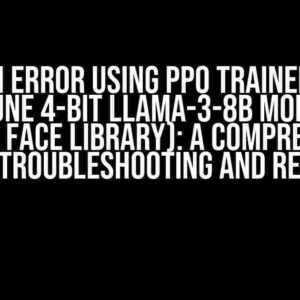Are you tired of encountering the frustrating “invalid_token_response” error while trying to retrieve an OAuth 2.0 Access Token Response? You’re not alone! This error can be a major roadblock in your development journey, but fear not, dear reader, for we’ve got you covered. In this article, we’ll delve into the world of OAuth 2.0, explore the causes of the “invalid_token_response” error, and provide you with step-by-step instructions to fix it.
What is OAuth 2.0 and How Does it Work?
Before we dive into the error, let’s take a quick look at OAuth 2.0 and how it works. OAuth 2.0 is an authorization framework that enables applications to access resources on behalf of the user, without exposing their credentials. It’s widely used in web and mobile applications to authenticate and authorize users.
In a typical OAuth 2.0 flow, the following steps occur:
- The client (your application) requests authorization from the resource server (e.g., Google, Facebook).
- The resource server redirects the user to the authorization server (e.g., Google Auth, Facebook Auth).
- The user grants access, and the authorization server issues an authorization code.
- The client exchanges the authorization code for an access token.
- The client uses the access token to access the protected resources.
The “invalid_token_response” Error: Causes and Symptoms
The “invalid_token_response” error occurs when the OAuth 2.0 access token response cannot be retrieved due to a PKIX path building failure. This error can manifest in different ways, such as:
- HTTP 400 Bad Request responses
- OAuth 2.0 token endpoint returning an error
- Failing to authenticate with the resource server
- Random authentication failures
Diagnosing the Issue: Understanding PKIX Path Building
PKIX (Public Key Infrastructure using X.509) is a standard for establishing trust in public keys. In the context of OAuth 2.0, PKIX path building is the process of verifying the identity of the authorization server. When the PKIX path building fails, the OAuth 2.0 access token response cannot be retrieved, resulting in the “invalid_token_response” error.
To diagnose the issue, you need to understand the following:
- X.509 certificates and certificate chains
- Trust anchors and trust stores
- Certificate validation and verification
Solving the “invalid_token_response” Error: Step-by-Step Guide
Now that we’ve covered the basics, let’s get to the solutions! Follow these steps to resolve the “invalid_token_response” error:
Step 1: Verify the Authorization Server’s Certificate
Check the authorization server’s certificate by performing the following steps:
openssl s_client -connect authorization-server.com:443 -servername authorization-server.com
This will show you the certificate chain. Verify that the chain is correct and the certificates are not expired.
Step 2: Check the Trust Anchor
Ensure that the trust anchor (root certificate) is correctly configured:
openssl s_client -connect authorization-server.com:443 -servername authorization-server.com -showcerts
Check that the trust anchor is present in the output.
Step 3: Configure the Trust Store
Configure the trust store to include the trust anchor:
keytool -importcert -v -trustcacerts -alias mytrustanchor -file path/to/trust-anchor.crt -keystore path/to/truststore.jks
Replace the placeholders with the actual values.
Step 4: Update the OAuth 2.0 Client
Update the OAuth 2.0 client to use the correct trust store:
OAuth2Client client = new OAuth2Client();
client.setTrustStore("path/to/truststore.jks", "password");
Replace the placeholders with the actual values.
Step 5: Test the OAuth 2.0 Flow
Test the OAuth 2.0 flow again to verify that the “invalid_token_response” error is resolved:
client.authorize("https://authorization-server.com/authorize");
If everything is configured correctly, you should receive a valid access token response.
Common Pitfalls and Troubleshooting Tips
Here are some common pitfalls and troubleshooting tips to keep in mind:
| Pitfall | Troubleshooting Tip |
|---|---|
| Expired certificates | Check the certificate expiration dates and renew them if necessary. |
| Incorrect trust anchor | Verify the trust anchor’s identity and ensure it’s correctly configured. |
| Trust store configuration issues | Double-check the trust store configuration and ensure it’s correctly imported. |
| OAuth 2.0 client configuration issues | Verify the OAuth 2.0 client configuration and ensure it’s using the correct trust store. |
Conclusion
In conclusion, the “invalid_token_response” error can be a frustrating and challenging issue to resolve. However, by understanding the underlying causes and following the step-by-step guide outlined in this article, you should be able to resolve the error and get your OAuth 2.0 flow working again. Remember to stay vigilant and regularly monitor your certificates and trust stores to avoid future issues.
By following the instructions and tips provided in this article, you’ll be well on your way to resolving the “invalid_token_response” error and enjoying a seamless OAuth 2.0 experience.
Frequently Asked Question
OAuth 2.0 errors got you down? Don’t worry, we’ve got your back! Here are the top 5 FAQs about “invalid_token_response – An error occurred while attempting to retrieve the OAuth 2.0 Access Token Response: PKIX path building failed” errors.
What does this error message even mean?
Don’t worry, it’s not as cryptic as it sounds! This error message means that there was an issue with the secure communication (HTTPS) between your app and the OAuth 2.0 server. Specifically, it couldn’t verify the identity of the server, so it refused to give you the access token.
What’s PKIX path building, anyway?
PKIX stands for Public Key Infrastructure X.509, and it’s a set of rules for verifying digital certificates. Think of it like a digital passport for servers. When a client (like your app) talks to a server, it needs to verify the server’s identity using these certificates. PKIX path building is the process of checking these certificates to make sure they’re valid and trustworthy.
How do I fix this error?
To fix this error, you’ll need to make sure your app is configured correctly for HTTPS communication. Check that your OAuth 2.0 server’s certificate is valid and up-to-date. You might need to update your app’s TLS/SSL settings or import the server’s certificate into your app’s truststore.
What if I’m using a self-signed certificate?
Self-signed certificates can be tricky! By default, most clients won’t trust self-signed certificates because they’re not verified by a trusted certificate authority. You might need to add an exception in your app’s configuration or import the self-signed certificate into your truststore. Be cautious, though – self-signed certificates can be risky if not handled properly.
Can I just ignore this error and move on?
Absolutely not! Ignoring this error can put your app’s security at risk. Without proper verification, your app might be vulnerable to man-in-the-middle attacks or other security threats. Take the time to fix the issue properly, and your users will thank you for keeping their data safe.



